Competency Area 2: Weed Management
PO 19.Chemical – Know example herbicides (product names), types of weeds they control, and weed/crop injury symptoms caused by each of the following herbicide site of action groups:
A. Growth regulators (synthetic auxins)
B. Amino acid synthesis inhibitors
C. Lipid synthesis inhibitors
D. Seedling root and shoot inhibitors
E. Photosynthesis inhibitors
F. Cell membrane disruptors
G. Pigment Inhibitors
H. Glutamine synthetase inhibitors
A. Growth regulators (synthetic auxins)
Growth regulators or synthetic auxins (GROUP 4) – act at multiple sites in plants to disrupt hormone balance and protein synthesis resulting in growth abnormalities.
Herbicide Family |
Chemical Name(s) |
Trade Name(s) |
Control |
| Phenoxy acetic acids |
2,4-D, MCPA,
2,4-DB |
Butyrac 200 |
|
| Benzoic acids |
dicamba |
Banvel, Clarity, Distinct, Status |
|
| Carboxylic acids |
clopyralid, triclopyr |
Stinger, Garlon |
|
| Injury: Corn shows onion-leafing, fused brace roots, bent and brittle stalks. Broadleaf plants show epinasty, callus tissue and leaf malformations. |
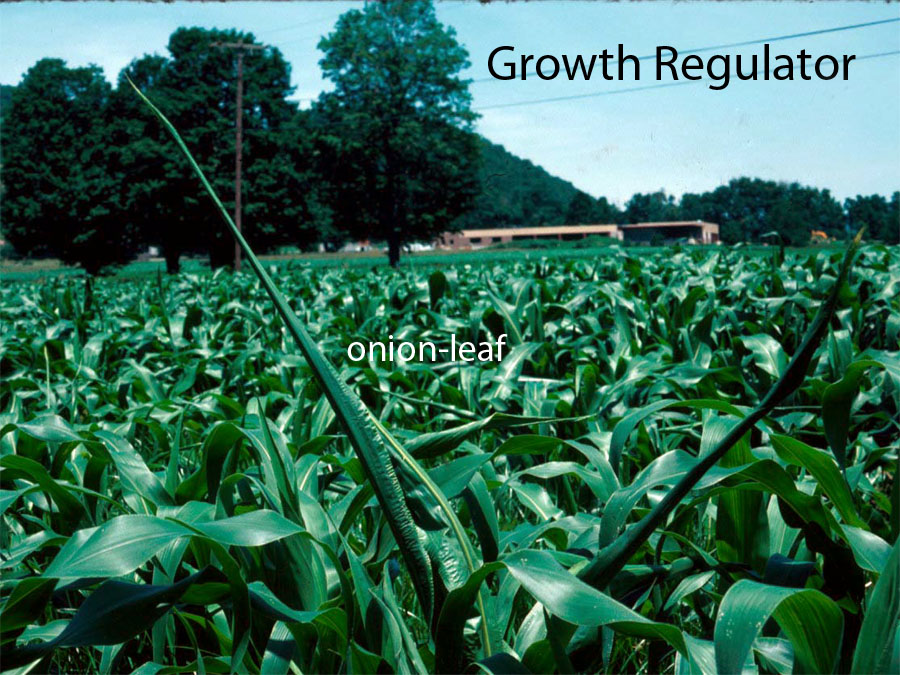 |
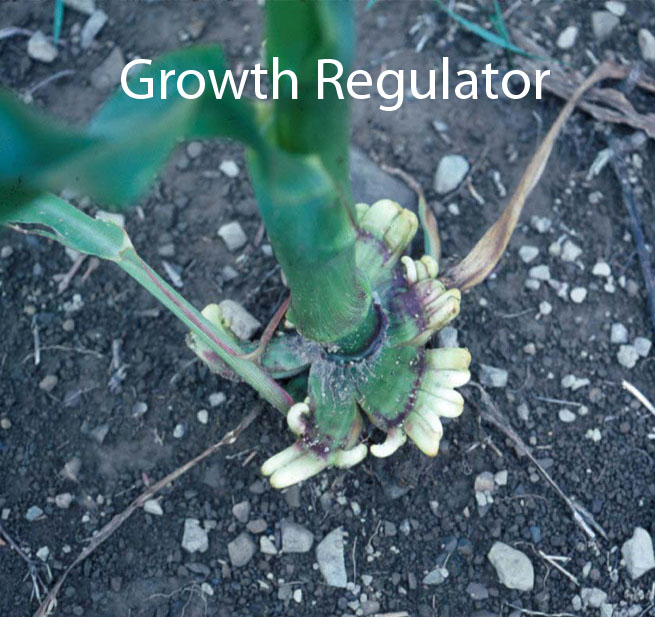 |
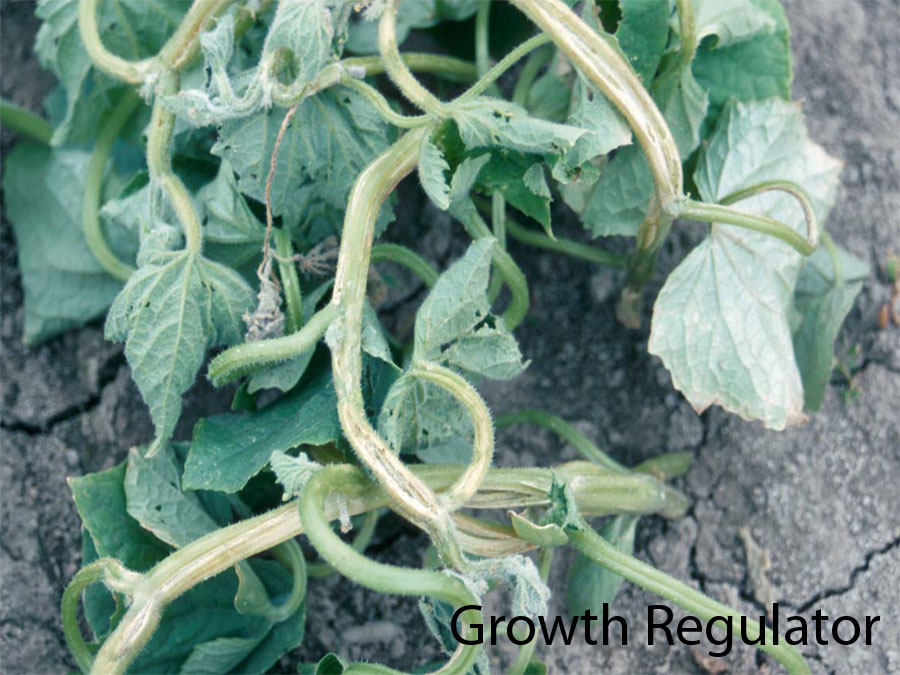 |
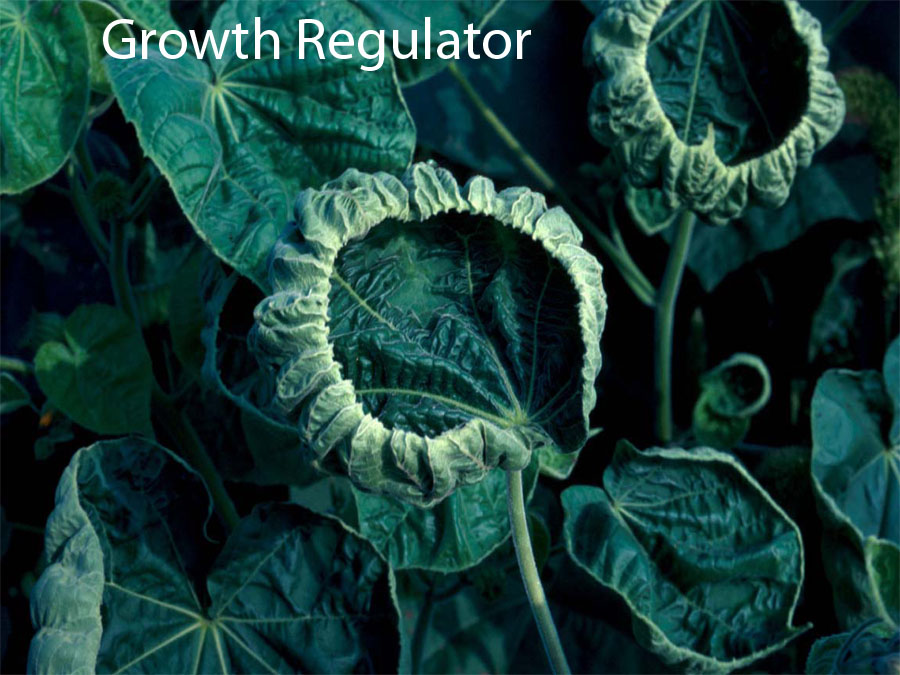 |
B. Amino acid synthesis inhibitors
Amino acid synthesis inhibitors - act on enzymes to prevent amino acid production.
Herbicide Family |
Chemical Name(s) |
Trade Name(s) |
Control |
ALS (acetolactate synthase) inhibitors (GROUP 2) |
| Imidazolinones |
imazethapyr,
imazamox |
Pursuit,
Raptor |
|
| Sulfonylureas |
halosulfuron,
nicosulfuron, primisulfuron,
rimsulfuron |
Permit
Accent
Beacon
Matrix |
|
| Triazolopyrimidines |
chloransulam-methy,l flumetsulam |
FirstRate,
Python |
|
EPSP synthase inhibitors (GROUP 9) |
| Glycines- (amino acid derivatives) |
glyphosate |
Roundup, Touchdown, etc. |
|
| Injury: Grass plants stunted with interveinal chlorosis or purpling. Broadleaf plants are stunted and chlorotic or purple. |
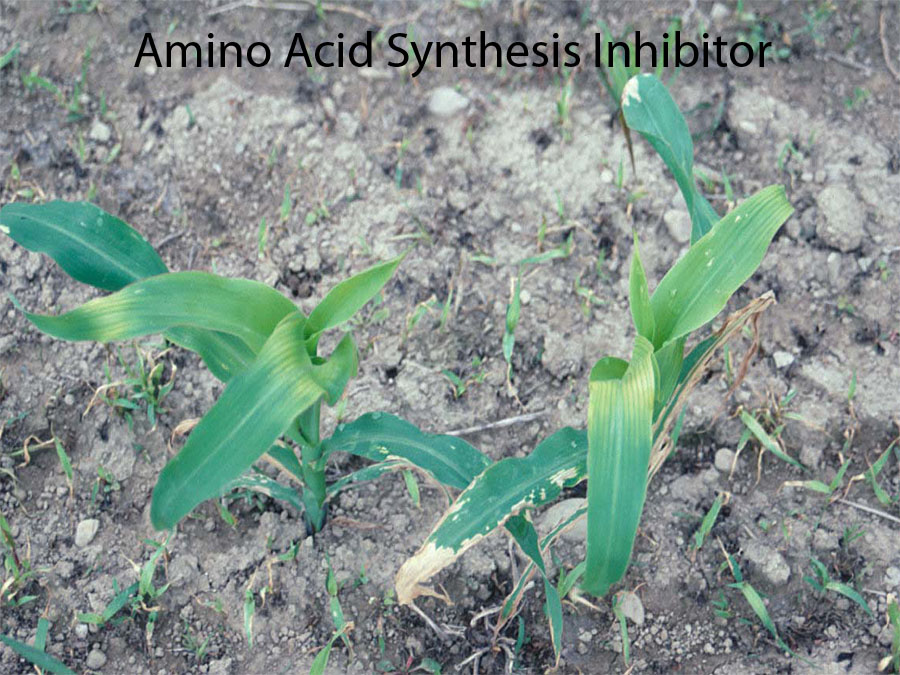 |
 |
C. Lipid synthesis inhibitors
Lipid synthesis inhibitors or ACCase inhibitors (GROUP 1) - affect grasses only by preventing formation of fatty acids essential for plant lipids which are vital to integrity of cell membranes and growth.
Herbicide Family |
Chemical Name(s) |
Trade Name(s) |
Control |
| Aryloxyphenoxypropionates |
fluazifop
quizalofop |
Fusilade
Assure II, Targa |
grasses |
| Cyclohexanediones |
sethoxydim
clethodim |
Poast Plus
Select |
grasses |
| Injury: Seen on grass plants only. New leaf tissue chlorotic or necrotic and leaves in whorl easily are separated from the plant. |
 |
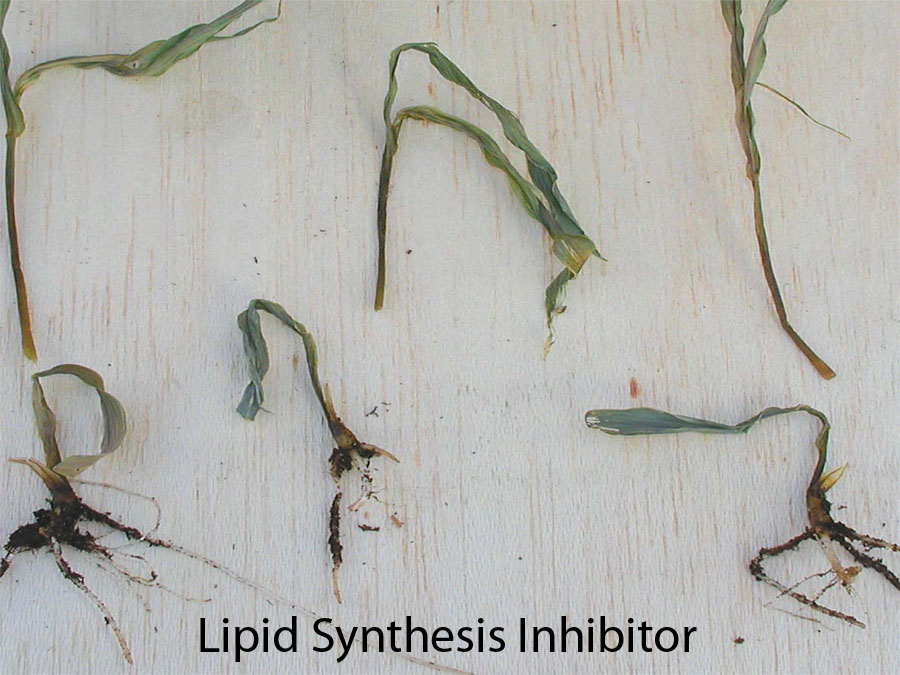 |
D. Seedling root and shoot inhibitors
Seedling growth inhibitors – inhibit root and/or shoot growth in developing seedlings.
Herbicide Family |
Chemical Name(s) |
Trade Name(s) |
Control |
| Root inhibitors or microtubule assembly inhibitors (GROUP 3) interfere with cell division |
| Dinitroanilines |
pendimethalin
trifluralin |
Prowl, Pendimax
Treflan |
|
Shoot inhibitors – interfere with lipid and protein synthesis. |
| Thiocarbamates or lipid synthesis inhibitors – not ACCase (GROUP 8) |
| Thiocarbamates |
EPTC |
Eptam |
|
| Acetamides or long–chain fatty acid inhibitors (GROUP 15) |
| Acetamides |
acetochlor
alachlor
dimethenamid-P
S-Metolachlor |
Surpass, Harness, etc.
Micro-Tech
Outlook
Dual II, Magnum, Cinch |
|
| Injury for Root Inhibitors: Stunted plants with short, thick lateral roots. Grass shoots may be red or purple. Broadleaf plants have swollen/cracked hypocotyls. |
 |
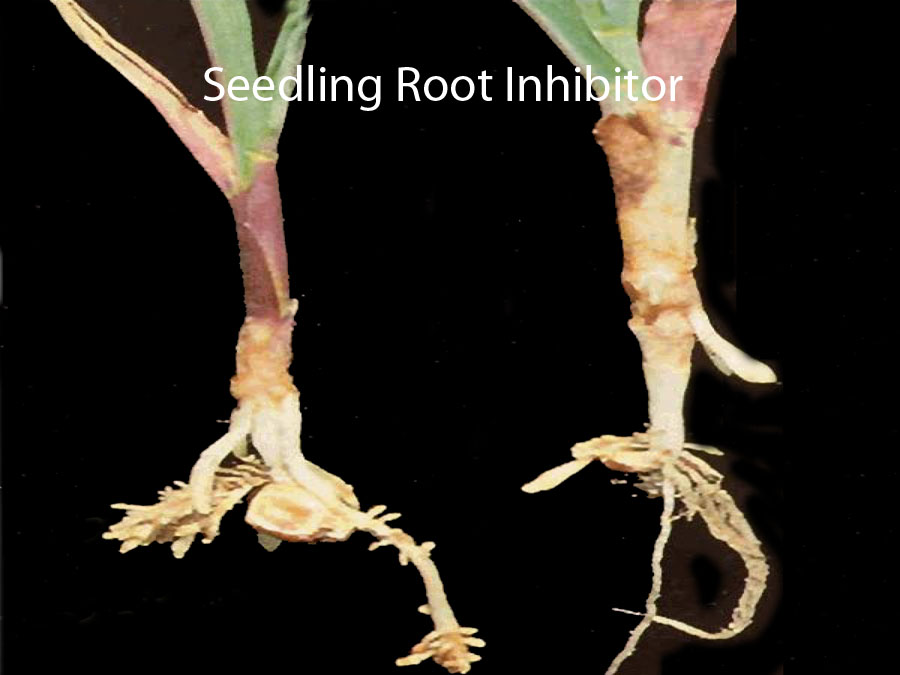 |
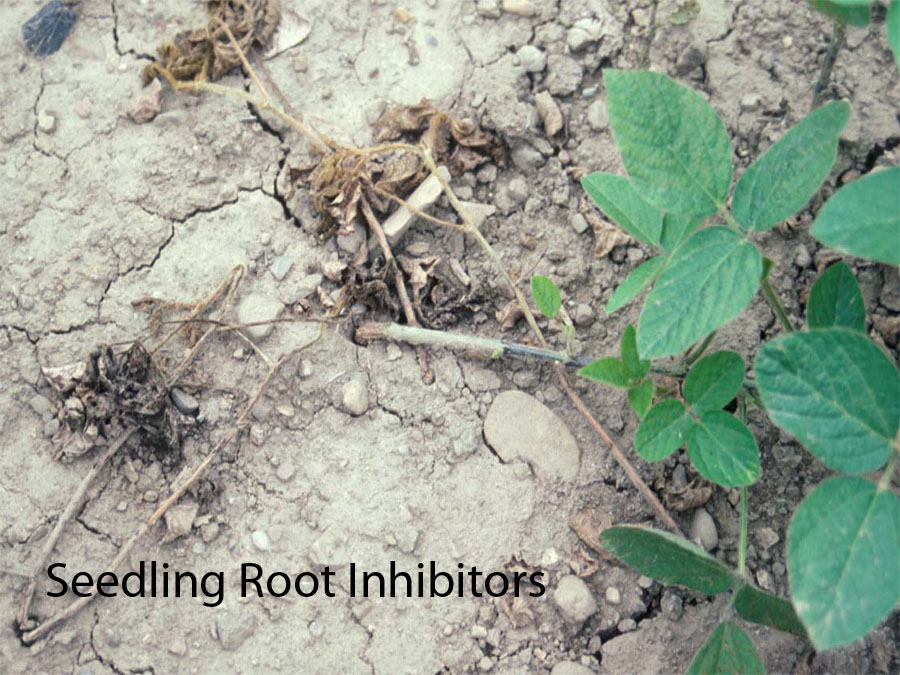 |
|
| Injury for Shoot Inhibitors: Grasses leaf out underground, leaves do not unfurl. Broadleaf plants have crinkled or puckered leaves and/or shortened mid-vein. |
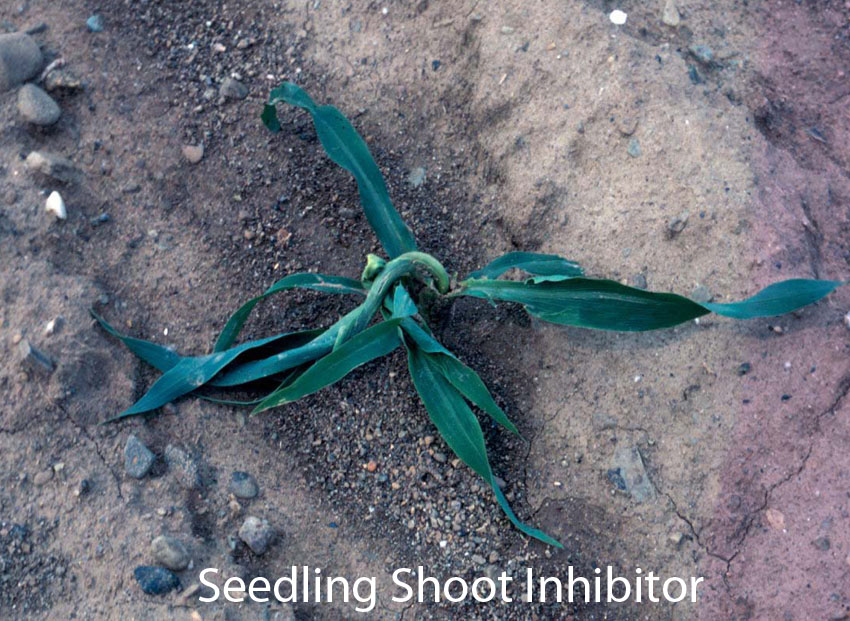 |
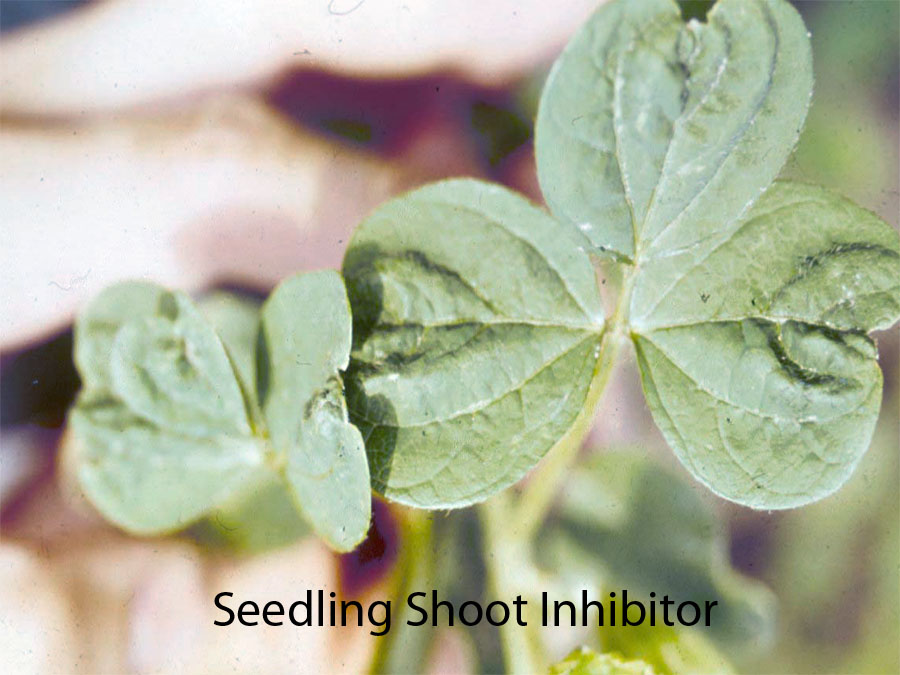 |
E. Photosynthesis inhibitors
Photosynthesis inhibitors – bind to specific sites within plant chloroplasts and stop carbohydrate production.
Herbicide Family |
Chemical Name(s) |
Trade Name(s) |
Control |
Mobile (translocated) photosynthesis inhibitors |
| Photo System II – site A (GROUP 5) |
| Triazines |
atrazine
simazine
prometone |
AAtrex
Princep
Pramitol |
|
Triazinones |
hexazinone
metribuzin |
Velpar
Sencor |
|
Uracils |
bromacil |
Hyvar X |
|
| Photo System II – site A, but different binding (GROUP 7) |
| Ureas |
linuron
tebuthiuron |
Lorox
Spike |
|
Nonmobile photosynthesis inhibitors |
| Photo System II – site B (GROUP 6) |
Nitriles |
bromoxynil |
Buctril |
|
Benzothiadiazoles |
bentazon |
Basagran |
|
Injury for Mobile Photosynthesis Inhibitors: Symptoms occur after leaves emerge. Chlorosis of older leaf margins or tips initially. Interveinal chlorosis in broadleaf plants. Tissue will turn brown and die. |
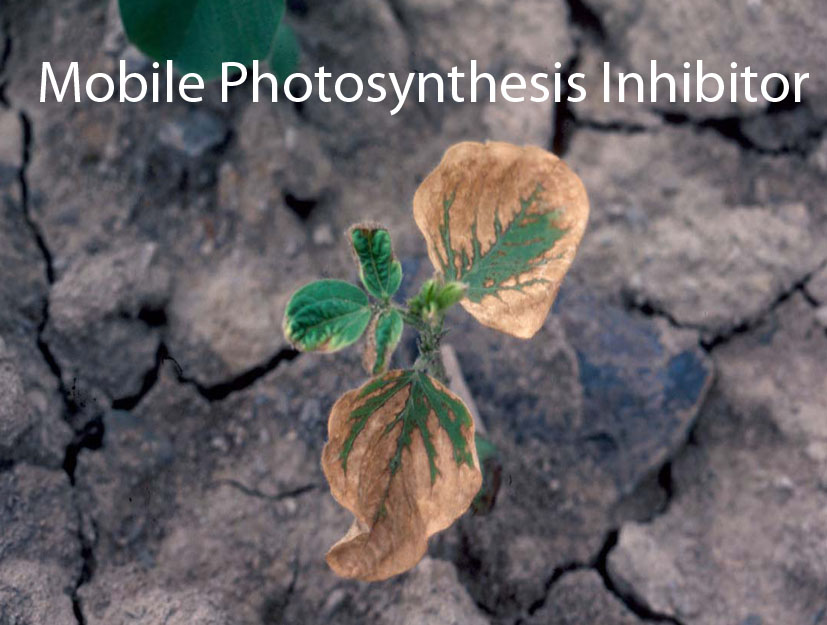 |
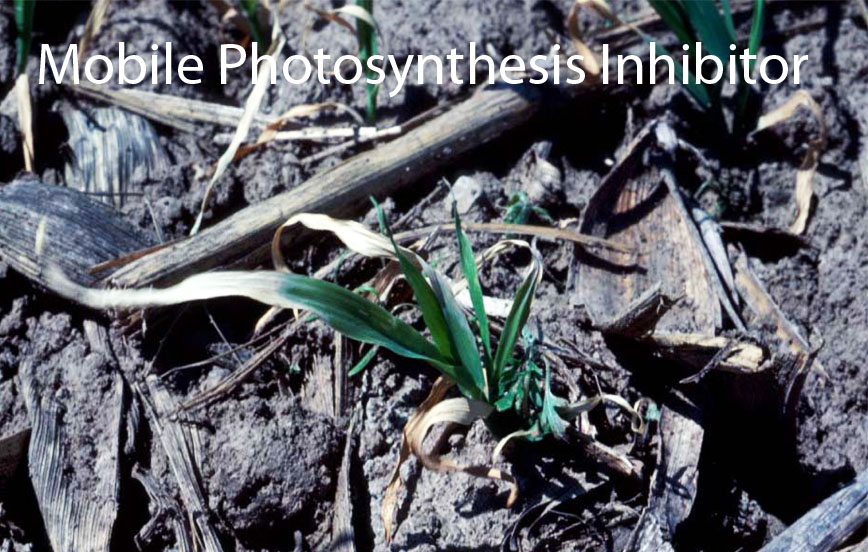 |
Injury for Non-mobile Photosynthesis Inhibitors: Leaves turn yellow or bronze and then turn brown and die. Symptoms are similar to those of cell membrane disruptors although less patterned though because there is no movement. |
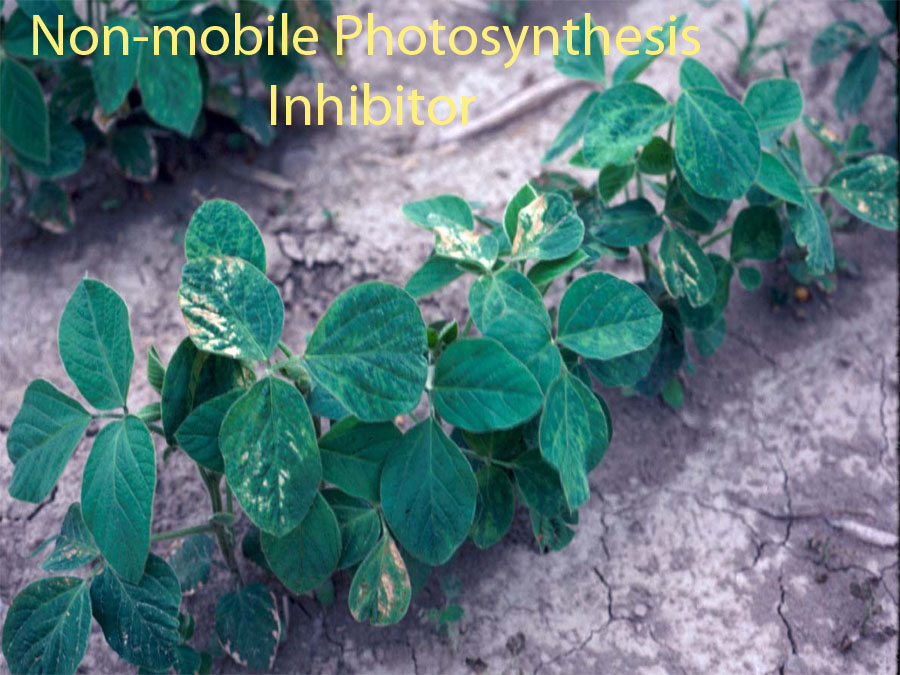 |
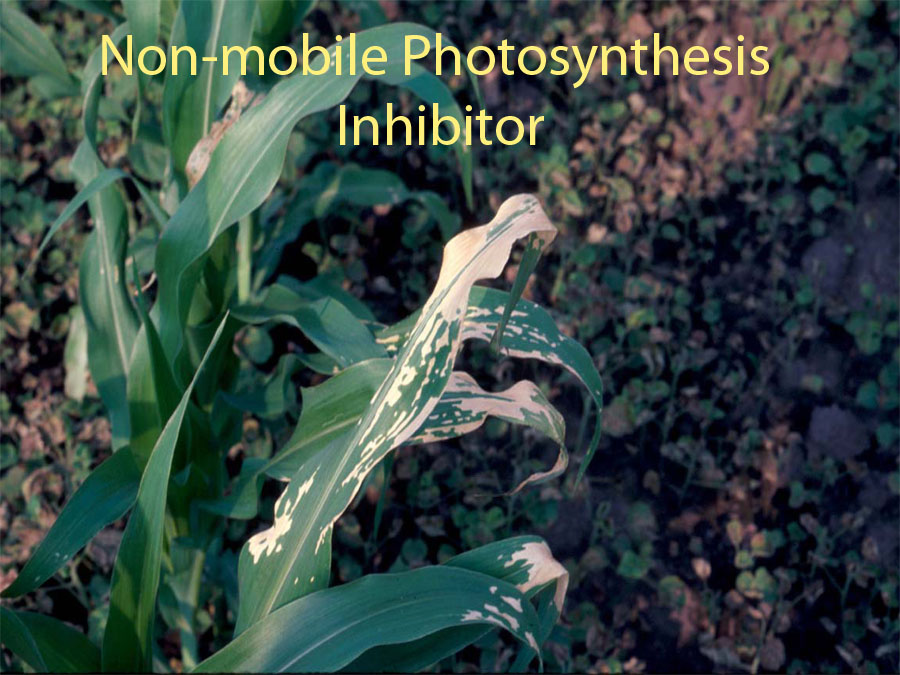 |
F. Cell Membrane Disruptors
Cell membrane disrupters – are activated by sunlight to form oxygen compounds such as hydrogen peroxide which rupture plant cell membranes
Herbicide Family |
Chemical Name(s) |
Trade Name(s) |
Control |
PPO inhibitors (GROUP 14) |
Diphenylethers |
fomesafen
lactofen |
Reflex
Cobra |
|
N-phenylphthalimides |
flumiclorac |
Resource |
|
Triazolinones |
carfentrazone
sulfentrazone |
Aim
Authority |
|
Photosystem I – electron diversion (GROUP 22) |
Bipyridiliums |
paraquat |
Gramoxone Inteon |
|
| Injury: With Gramoxone Inteo, a water soaked appearance followed by necrosis. With the others, leaves turn yellow then bronze/brown and die. |
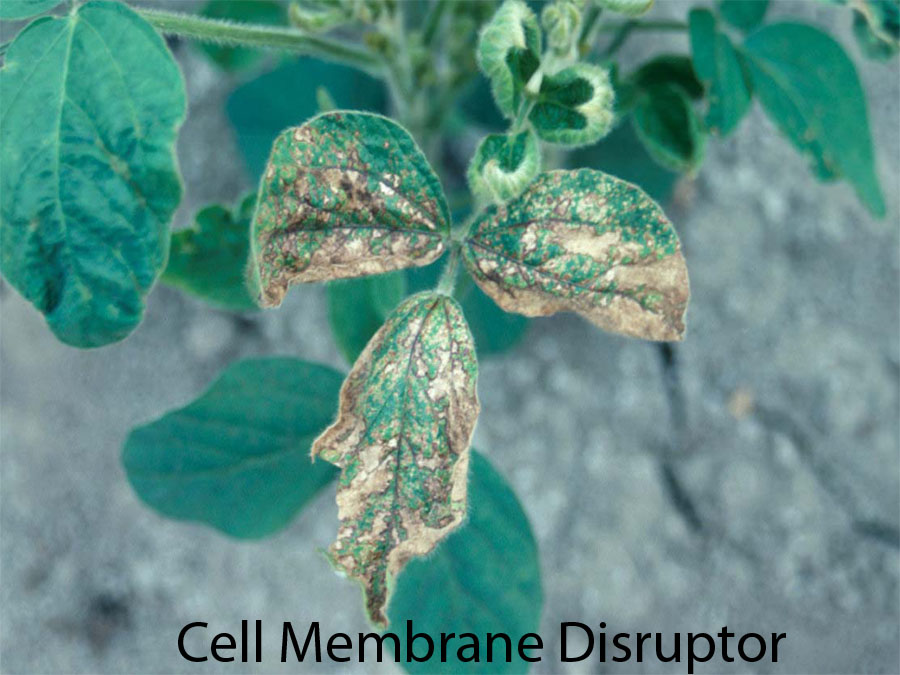 |
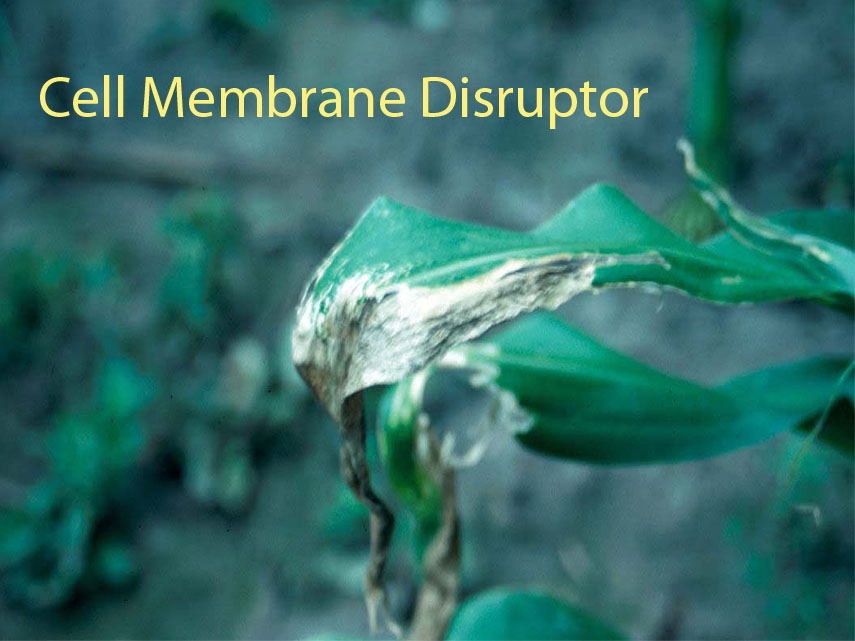 |
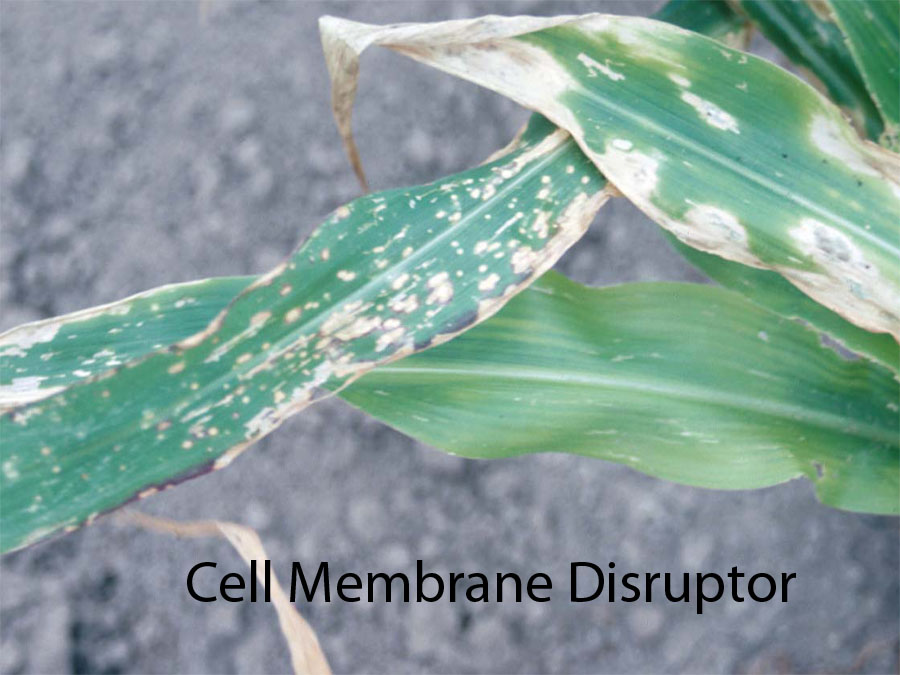 |
|
G.Pigment inhibitors
Pigment inhibitors – prevent formation of photosynthetic pigments
Herbicide Family |
Chemical Name(s) |
Trade Name(s) |
Control |
DOXP synthase inhibitors (GROUP 13) |
Isoxazolidinones |
clomazone |
Command |
|
4-HPPD inhibitors (GROUP 27) |
Triketones |
mesotrione |
Callisto |
|
Pyrazoles |
topramezone |
Impact |
|
| Injury: Plants turn white, often becoming translucent at the leaf tips. |
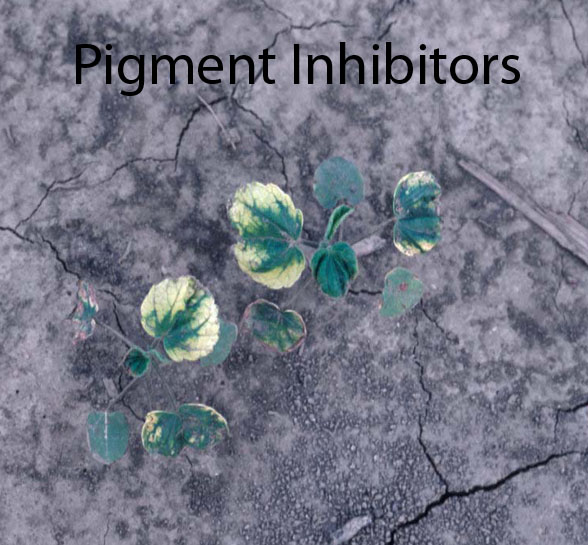 |
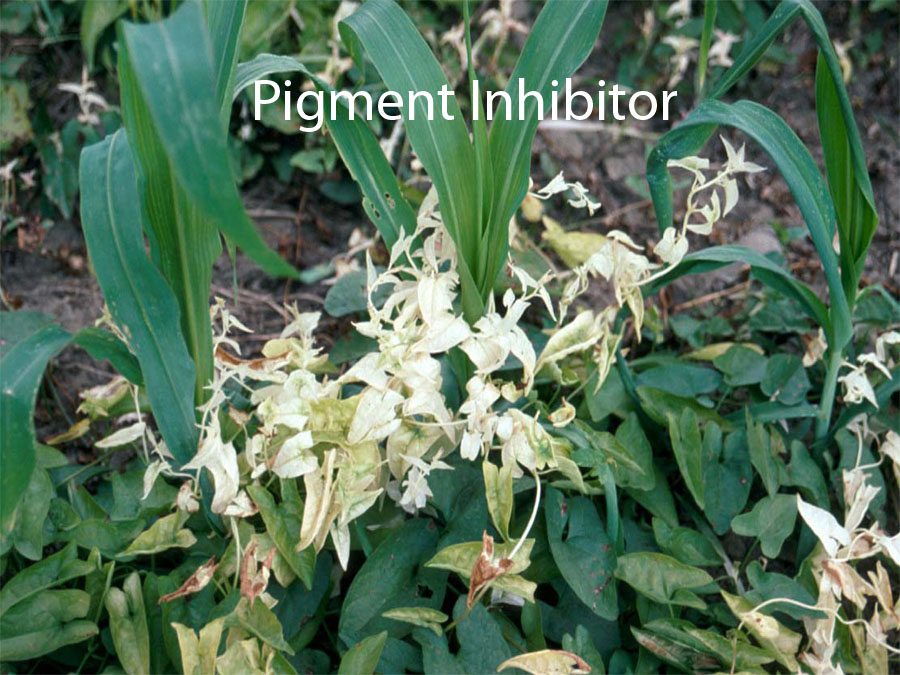 |
H.Glutamine Synthetase inhibitor
Glutamine synthetase inhibitors (GROUP 10) – inhibit the enzyme that converts glutamate plus ammonia to glutamine. The accumulation of ammonia in plants destroys cell walls and directly inhibits Photosystem I and Photosystem II reactions. Theree is no accepted chemical family, however sometimes referred to as phosphorylated amino acids or amino acid derivatives –
Herbicide Family |
Chemical Name(s) |
Trade Name(s) |
Control |
See statement above |
glufosinate |
Liberty, Ignite, etc. |
|
| Injury: causes chlorosis and wilting within 3-5 days after application, followed by necrosis in 1-2 weeks. Translocation in plants is quite limited. |
 |
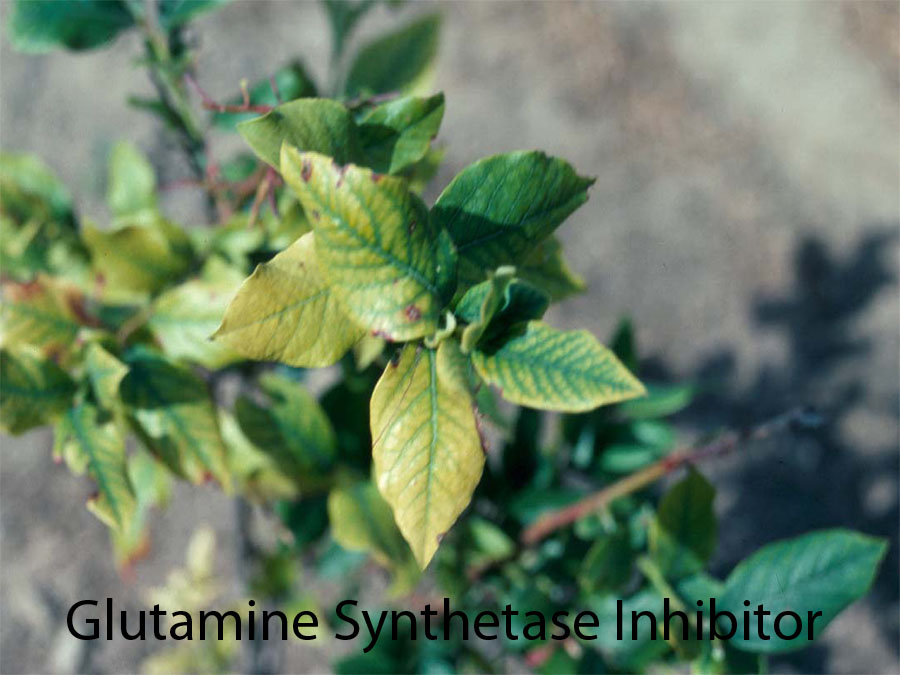 |
























